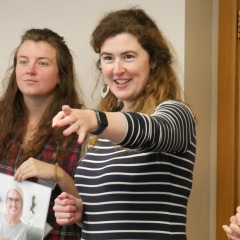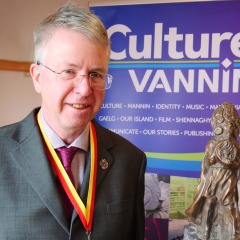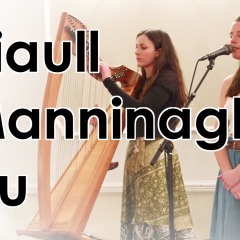Marion Shimmin: A biographical sketch
Mon, 01 Jul 2019
Despite being the Isle of Man's first female MHK, little of great depth has been written of Marion Shimmin. After meeting with Kate Matthews, Marion Shimmin's Great Grandaughter, we received this short biographical sketch of the politician, adapted by Kate from something written by her aunt, Jannis Shimmin. As it is a biographical sketch of greater length and detail then anything we have come across before, we post it here for others to enjoy and learn from. It is posted with thanks to Kate Matthews:
MARION FALLOWS SHIMMIN
Marion Shimmin took her role as the first female MHK incredibly seriously. She was widely recognised as a figure of integrity with a proven determination to affect change in Peel.
Marion showed early signs of social engagement alongside a determined streak of active autonomy. Born in Manchester in 1879 to Caroline and James Fallows, Marion was the second of five children. The Family followed James to Europe with his work as an engineer, once spending three years in Lodz (now in Poland). The fallows were an encouraging family; imbuing a love of the arts, travel and science into their children. Greatly encouraged by her mother, Marion studied classical music in Manchester, qualifying as a teacher. In this inspiring environment, she was able to explore her wider passions, especially a growing interest in social welfare.
Marion was unable to comprehend the dire circumstances of the poor in Manchester while working as a music teacher in Salford. Looking for active ways to make a difference, she joined the Temperance movement. This provided her with a platform for her growing concerns about the devastating social consequences for families when the main breadwinners often spent their entire income on alcohol.
Encouraged, Marion visited and documented the conditions in the slum areas of Manchester and Liverpool; reporting on the squalor and grinding poverty. The plight of women in these circumstances was to become the focus of her political career. She campaigned against what we would now call domestic violence both in the UK and Isle of Man.
Her parents, although not openly against her growing political views, Marion’s activism and willingness to “go against the grain” could not have gone unnoticed. The musical break in Vienna she was strongly encouraged to take, proved not to be the distraction her family intended. Also visiting Vienna in 1904 was Christopher Shimmin; Manxman, fellow activist and Marions future husband.
Before meeting Marion, Christopher had returned from the US in disgust with the racial prejudices he witnessed. Coincidentally, he took a job in Liverpool as part of the continuing development of sanitary innovation; painstakingly reporting and mapping the unhealthy slum accommodation for the working classes. Cristopher and Marion found that their interests and values matched exactly. The couple were married at St Aidans Church, Bamber Bridge, Lancashire on 17th September 1906 before settling in Peel where Marion taught music at the Old Methodist school in Tynwald Road. The Isle of Man, specifically Peel, was forever to be both Marion’s passion and home.
The Shimmins continued to work together on the island. Marion, in particular, promoting the rights of women and children. She discovered that as in Manchester, many women were left bruised and penniless after the men spent their wages on returning from the fishing. Christopher was elected to the house of keys three times from 1919 onwards; enthusiastically supported by Marion. She encouraged Christopher to expose unfair practices against the working people of Peel, especially injustices which affected women and children. Namely, food prices, fraudulent weights and measures, education and low wages on the boats.
Marion's independent commitment to improve the quality of life for ordinary working people was recognised, as after the death of Christopher in 1933, she was elected as MHK for Peel. Her election was by no means a forgone conclusion off the back of her husband’s position. In fact, attempts were made to block her campaign and election.
Her time in office was a continuation of her life’s work: to improve the lives of women, children and the poor. The Manx people and their way of life was of great interest to Marion. She became highly knowledgeable on the Island’s history and artistic culture. As a musician she delighted in Manx reels. Both Marion and Christopher understood the power of art as a vessel of cultural history. As proactive MHK’s, they made great efforts to connect with and empower the people Peel (not always welcomed!). The stories, language and music they collected along the way, informed the work of Yn Çheshaght Ghailckagh (The Manx Language society) of which Christopher was a prominent figure alongside follow collectors and creatives Sophia Morrison, WH Gill etc.
Stories of Marion’s ability to cut through the red tape if necessary were many and various. For example, whilst on leave from the Airforce in 1940, her son John (Jack) had forgotten his promise to drive her to a Tynwald meeting. Not wanting to miss any business, she took matters into her own hands and, without any known skills, drove herself to Douglas. Apparently afterwards, she didn't know what all the fuss was about!
Obviously a formidable character, soberly dressed and softly spoken, her sons spoke of the fun she brought to the family. She could raise the tempo with lively fiddle music and popular piano tunes. Jack and Ffinlo were raised as artists (monumental masons) themselves with a keen interest in politics. Apparently Marion often told her sons how she regretted not being born Manx.
Considering her love and dedication to the Isle of Man and its people, Marion Shimmin MHK, the first woman in Tynwald, can certainly be recognised as a true Manx woman.
Recent News
-

New Manx dance commission
Tue, 14 May 2024
-

Complete T. E. Brown recording
Wed, 01 May 2024
-

Year-long series of Manx foklore articles
Mon, 29 Apr 2024
-

Rinkaghyn Vannin: Manx dance book and cassette released online
Thu, 18 Apr 2024
-

Travel Insighter article on the Isle of Man
Wed, 17 Apr 2024
-

Vin Diesel to star in film version of the Buggane of St Trinian's
Mon, 01 Apr 2024
-

Manx Gaelic Summer School
Tue, 12 Mar 2024
-

March Manx music and dance newsletter
Fri, 01 Mar 2024
-

Adrian Corkill awarded the RBV for his work on Manx shipwrecks
Fri, 23 Feb 2024
-

February Manx music and dance newsletter
Thu, 01 Feb 2024

